Methamphetamine (meth) is a strong stimulant that’s become a major player in the world of substance abuse. One of the key questions that arises is, “what does methamphetamine look like?” From the physical characteristics of meth to its various forms and the broader impact of its use, understanding this dangerous drug can save lives.
What Is Crystal Meth?
Crystal meth (methamphetamine) is a potent and highly addictive central nervous system stimulant. Some slang terms you might hear for methamphetamine are meth, chalk, crank, crystal, glass, tweak, ice, or tina. Originating from illegal labs, crystal meth is a man-made drug derived from amphetamine, a synthetic mood-altering stimulant.
A Japanese chemist first synthesized meth in 1893. In 1919, the chemist Akira Ogata streamlined the manufacturing process. He created crystal meth by combining phosphorus and iodine. Today, meth is typically made by combining over-the-counter medications and toxic chemicals. The process is dangerous, leading not only to the production of the drug but also hazardous waste.
The production, sale, and use of methamphetamine are illegal in most places due to its high potential for abuse and severe health risks.
What Does Meth Feel Like?
Methamphetamine greatly increases the release of dopamine in the brain, resulting in intense feelings of pleasure and euphoria. Smoking or injecting meth puts the drug very quickly into the bloodstream and brain, causing an immediate, intense “rush” or “flash.” This lasts only a few minutes and is described as extremely pleasurable. Snorting or oral ingestion produces a euphoric high, but not an intense rush. Snorting produces effects within 3 to 5 minutes, and oral ingestion produces effects within 15 to 20 minutes.
How Long Is Meth in Your System?
Many people wonder: how long does meth last? The effects of meth can last anywhere from around 8-24 hours, depending on how much is taken, the time of day, how it was administered (IV, oral, etc.), how well the kidneys and liver are functioning, and your unique body chemistry. The physical consequences of meth use can be severe, including dental issues (often referred to as “meth mouth”), skin sores, and mental health deterioration.
Startling Meth Statistics
Among people aged 12 or older in 2021, about 2.5 million people reported using methamphetamine in the past 12 months. Statistics also indicate a disturbing rise in methamphetamine-related incidents. In 2021, approximately 32,537 people died from an overdose involving psychostimulants with abuse potential other than cocaine (primarily methamphetamine).
What Does Methamphetamine Look Like?
Because methamphetamine can be produced using many different methods, its appearance can vary dramatically. In its purest form, meth is a white crystalline powder that’s odorless, bitter-tasting, and dissolves easily in water or alcohol.
Depending on how the meth was made, it can come in a variety of hues, including brown, yellow-gray, orange, blue, and pink. Meth manufacturers have been known to add food coloring or dye to batches of meth to help sell their product. Meth producers will often cut real meth with other substances, or sell counterfeit powders to pass it off as what looks like meth.
Meth can also be compressed into pill form or a less-common waxy, gooey oil called meth base.
People use methamphetamine in several ways. Some smoke it, some snort it, and others inject it. The way it’s consumed can affect the intensity and duration of the drug’s impact.
Meth’s Portrayal in Society and Media
Often depicted as a destructive force, methamphetamine’s impact on individuals and communities has been showcased in many documentaries, TV shows, and movies. Characters struggling with addiction are portrayed as erratic, desperate, and sometimes violent. These portrayals serve as cautionary tales, aiming to highlight the dangers of methamphetamine abuse.
It’s essential to recognize that media portrayals can sometimes oversimplify the complex issue of methamphetamine addiction. While they shed light on the negative aspects of the drug, they may not capture the underlying factors contributing to addiction, such as socioeconomic challenges, mental health issues, and lack of access to proper treatment. The media’s portrayal can also contribute to the stigmatization of individuals facing methamphetamine addiction. This stigma can hinder their willingness to seek help and perpetuate misconceptions about the nature of addiction.
Depictions of meth use and distribution can also have a real-world impact. Several years ago, for example, meth manufacturers started adding blue coloring to the drug to mimic the supposedly pure-blue meth featured on the TV series Breaking Bad.
Signs and Symptoms of Meth Abuse
Recognizing the signs and symptoms of meth abuse is crucial for early intervention. Here are some key indicators:
Behavioral Signs
- Hyperfocus and repetitive behaviors, like constantly picking at the skin or compulsively cleaning
- Social isolation
- Strained relationships
Psychological Signs
- Cognitive impairment, including memory issues, limited attention span, poor decision-making abilities, impaired judgment
- Mood swings ranging from extreme euphoria to intense irritability, are common
- Hyperactivity, talkativeness
- Paranoia and hallucinations
- Aggression
Physical Health Signs
- Cardiovascular issues, such as high blood pressure, irregular heartbeat, and increased risk of heart attack
- Tooth loss and decay (known as “meth mouth)
- Erratic sleep patterns
- Rapid weight loss
- Dilated pupils
- Acne
Environmental Clues
- Presence of paraphernalia, such as pipes, syringes, or small bags with crystal-like residue, can indicate meth use
How Is Crystal Meth Addiction Treated?
Addressing crystal meth addiction involves a comprehensive approach that considers an individual’s physical, mental, and social aspects. Treatment typically includes:
- Detoxification under medical supervision to safely remove methamphetamine from the body
- Cognitive-behavioral therapy, individual and group counseling, support groups
- Medication to manage withdrawal symptoms and cravings
Meth Treatment at Aliya Health Group
A meth addiction is difficult to overcome, but possible with the right treatment, support, and motivation. Aliya Health Group offers evidence-based substance abuse and mental health treatment that addresses the root causes of methamphetamine addiction.
Our holistic approach to addiction treatment teaches you healthier ways to cope without the drug and helps you begin repairing the mental and physical effects of meth abuse. Our tailored treatment programs encompass:
Detox Services: Medically supervised detoxification to ensure a safe withdrawal process.
Therapeutic Approaches: To address the underlying causes of addiction, including trauma, a dual-diagnosis, and other challenges
Aftercare Planning: Continued support and resources for a successful transition back to daily life
If you or someone you know is struggling with methamphetamine addiction, seeking help is the first step towards a healthier future. Aliya Health Group is here to support you on that journey.

















